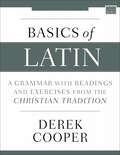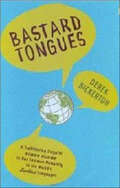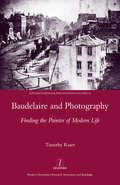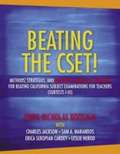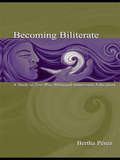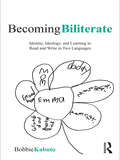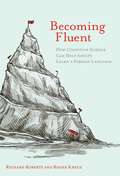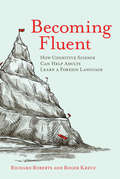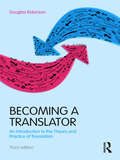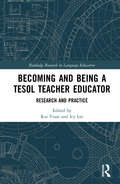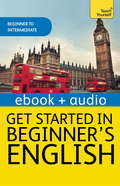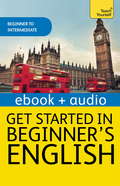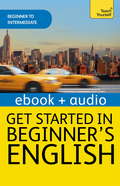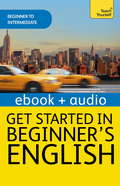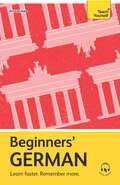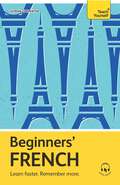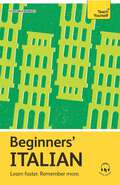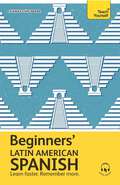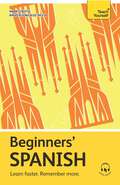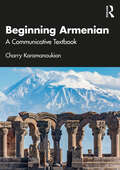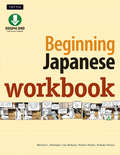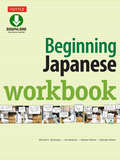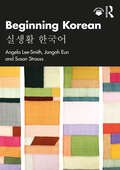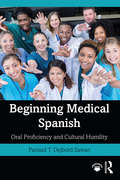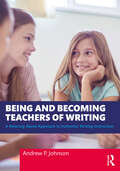- Table View
- List View
Basics of Latin: A Grammar with Readings and Exercises from the Christian Tradition
by Derek CooperBasics of Latin: A Grammar with Readings and Exercises from the Christian Tradition by Derek Cooper introduces students, independent learners, and homeschoolers to the basics of Latin grammar with all readings and exercises taken from texts in the Christian tradition.As part of the widely-used Zondervan Language Basics series of resources, Cooper's Latin grammar is a student-friendly introduction. It helps students learn by:Minimizing technical jargonProviding only the information needed to learn the basicsBreaking the grammar of language down into manageable and intuitive chunksIllustrating the grammar in question by its use in rich selections from ancient Christian authors.Providing grammar, readings, exercises, and a lexicon all in one convenient volume.Basics of Latin provides an ideal first step into this important language and focuses on getting the student into texts and translation as quickly as possible.
Bastard Tongues: A Trailblazing Linguist Finds Clues to Our Common Humanity in the World's Lowliest Languages
by Derek BickertonWhy Do Isolated Creole Languages Tend to Have Similar Grammatical Structures?Bastard Tongues is an exciting, firsthand story of scientific discovery in an area of research close to the heart of what it means to be human—what language is, how it works, and how it passes from generation to generation, even where historical accidents have made normal transmission almost impossible. The story focuses on languages so low in the pecking order that many people don't regard them as languages at all—Creole languages spoken by descendants of slaves and indentured laborers in plantation colonies all over the world. The story is told by Derek Bickerton, who has spent more than thirty years researching these languages on four continents and developing a controversial theory that explains why they are so similar to one another. A published novelist, Bickerton (once described as "part scholar, part swashbuckling man of action") does not present his findings in the usual dry academic manner. Instead, you become a companion on his journey of discovery. You learn things as he learned them, share his disappointments and triumphs, explore the exotic locales where he worked, and meet the colorful characters he encountered along the way. The result is a unique blend of memoir, travelogue, history, and linguistics primer, appealing to anyone who has ever wondered how languages grow or what it's like to search the world for new knowledge.
Baudelaire and Photography: Finding the Painter of Modern Life
by Timothy RaserWhile Baudelaire's 'Le Peintre de la vie moderne' is often cited as the first expression of our theory of modernism, his choice of Constantin Guys as that painter has caused consternation from the moment of the essay's publication in 1863. Worse still, in his 'Salon de 1859', Baudelaire had also chosen to condemn photography in terms that echo to this day. Why did the excellent critic choose a mere reporter and illustrator as the painter of modern life? How could he have overlooked photography as the painting of modern life? In this study of modernity and photography in Baudelaire's writing, Timothy Raser, who has written on the art criticism of Baudelaire, Proust, Claudel and Sartre, shows how these two aberrations of critical judgment are related, and how they underlie current discussions of both photography and modernism. Timothy Raser is Professor of French at the University of Georgia (USA).
Beating the CSET! Methods, Strategies, and Multiple Subjects Content for Beating the California Subject Examinations for Teachers (Subtests I-III)
by Chris N. BoosalisBeating the CSET! will help both pre-service and practicing teachers in California pass the CSET Multiple Subjects Subtests I - III. This new text has been designed to address the essential time-management methods.
Becoming Biliterate: A Study of Two-Way Bilingual Immersion Education
by Bertha PerezThis book describes the development process and dynamics of change in the course of implementing a two-way bilingual immersion education program in two school communities. The focus is on the language and literacy learning of elementary-school students and on how it is influenced by parents, teachers, and policymakers. Pérez provides rich, highly detailed descriptions, both quantitative and qualitative, of the change process at the two schools involved, including student language and achievement data for five years of program implementation that were used to test the basic two-way bilingual theory, the specific school interventions, and the particular classroom instructional practices. The contribution of Becoming Biliterate: A Study of Two-Way Bilingual Immersion Education is to provide a comprehensive description of contextual and instructional factors that might help or hinder the attainment of successful literacy and student outcomes in both languages. The study has broad theoretical, policy, and practical instructional relevance for the many other U.S. school districts with large student populations of non-native speakers of English. This volume is highly relevant for researchers, teacher educators, and graduate students in bilingual and ESL education, language policy, linguistics, and language education, and as a text for master's- and doctoral-level classes in these areas.
Becoming Biliterate: Identity, Ideology, and Learning to Read and Write in Two Languages
by Bobbie KabutoThrough the real-life context of one child learning to be bilingual and biliterate, this book raises questions and provides a context for pre-service and practicing teachers to understand and reflect on how children learn to read and write in multiple languages. Highlighting the social and cognitive advantages of biliteracy, its purpose is to help teachers better understand the complexity by which young children become biliterate as they actively construct meaning and work through tensions resulting from their everyday life circumstances. Perspectives regarding identity and language ideologies are presented to help teachers refine their own pedagogical approaches to teaching linguistically diverse children. Readers are engaged in understanding early biliteracy through a process of articulating and questioning their own assumptions and beliefs about learning in multiple languages and literacies.
Becoming Fluent
by Richard M. Roberts Roger J. KreuzAdults who want to learn a foreign language are often discouraged because they believe they cannot acquire a language as easily as children. Once they begin to learn a language, adults may be further discouraged when they find the methods used to teach children don't seem to work for them. What is an adult language learner to do? In this book, Richard Roberts and Roger Kreuz draw on insights from psychology and cognitive science to show that adults can master a foreign language if they bring to bear the skills and knowledge they have honed over a lifetime. Adults shouldn't try to learn as children do; they should learn like adults.Roberts and Kreuz report evidence that adults can learn new languages even more easily than children. Children appear to have only two advantages over adults in learning a language: they acquire a native accent more easily, and they do not suffer from self-defeating anxiety about learning a language. Adults, on the other hand, have the greater advantages -- gained from experience -- of an understanding of their own mental processes and knowing how to use language to do things. Adults have an especially advantageous grasp of pragmatics, the social use of language, and Roberts and Kreuz show how to leverage this metalinguistic ability in learning a new language.Learning a language takes effort. But if adult learners apply the tools acquired over a lifetime, it can be enjoyable and rewarding.
Becoming Fluent: How Cognitive Science Can Help Adults Learn a Foreign Language (The\mit Press Ser.)
by Richard Roberts Roger KreuzHow adult learners can draw upon skills and knowledge honed over a lifetime to master a foreign language.Adults who want to learn a foreign language are often discouraged because they believe they cannot acquire a language as easily as children. Once they begin to learn a language, adults may be further discouraged when they find the methods used to teach children don't seem to work for them. What is an adult language learner to do? In this book, Richard Roberts and Roger Kreuz draw on insights from psychology and cognitive science to show that adults can master a foreign language if they bring to bear the skills and knowledge they have honed over a lifetime. Adults shouldn't try to learn as children do; they should learn like adults.Roberts and Kreuz report evidence that adults can learn new languages even more easily than children. Children appear to have only two advantages over adults in learning a language: they acquire a native accent more easily, and they do not suffer from self-defeating anxiety about learning a language. Adults, on the other hand, have the greater advantages—gained from experience—of an understanding of their own mental processes and knowing how to use language to do things. Adults have an especially advantageous grasp of pragmatics, the social use of language, and Roberts and Kreuz show how to leverage this metalinguistic ability in learning a new language.Learning a language takes effort. But if adult learners apply the tools acquired over a lifetime, it can be enjoyable and rewarding.
Becoming a Translator: An Introduction to the Theory and Practice of Translation
by Douglas RobinsonFusing theory with advice and information about the practicalities of translating, Becoming a Translator is the essential resource for novice and practicing translators. The book explains how the market works, helps translators learn how to translate faster and more accurately, as well as providing invaluable advice and tips about how to deal with potential problems, such as stress. The third edition has been revised and updated throughout, offering: extensive up-to-date information about new translation technologies discussions of the emerging "sociological" and "activist" turns in translation studies new exercises and examples updated further reading sections a website containing a teacher’s guide, the chapter ‘The Translator as Learner’ and additional resources for translators Offering suggestions for discussion, activities, and hints for the teaching of translation, the third edition of Becoming a Translator remains invaluable for students and teachers of Translation Studies, as well as those working in the field of translation.
Becoming and Being a TESOL Teacher Educator: Research and Practice (Routledge Research in Language Education)
by Yuan Rui Lee IcyThis book offers insights into the lived experiences (e.g., teaching, research, and practicum supervision) of TESOL teacher educators in diverse institutional and socio-cultural contexts. Informed by a situated, ecological perspective, it draws on a variety of research approaches (e.g., qualitative, action research, and self-study), and sheds light on how language teacher educators engage in daily practice and social interactions. This edited collection examines how TESOL educators cope with potential contextual obstacles (e.g., the theory-practice divide), and how they seek their continuing professional development in complex, shifting higher education settings. The book offers critical and thoughtful reflections of current practice and policies in language education and higher education, and provides practical implications on the preparation and development of frontline language teachers.
Beginner's English (Learn BRITISH English as a Foreign Language): Enhanced Edition
by Cindy CheethamDo you want a solid foundation to your English studies?If you are looking for a solid foundation to your language studies for school, work or travel, this engaging course will get you speaking, writing, reading and understanding English in no time. Through authentic conversations, clear language presentations, and extensive practice and review, you will learn the English you need to communicate naturally in everyday situations - from booking a hotel room to talking about friends and family.What will I learn?The course focuses on British English but offers American alternatives. Basic English is slowly and carefully introduced to ensure you progress confidently through the course and build up a foundation to allow you to feel confident in everyday situations and move to the next level of your learning. It teaches grammar, vocabulary and listening, reading, writing, speaking and pronunciation skills. By the end of the course you will reach a solid Novice High proficiency level of ACTFL (The American Council for the Teaching of Foreign Languages) and A2 Beginner level of the CEFR (Common European Framework of Reference for Languages) guidelines. Is this course for me?Get Started in English is for absolute and false beginners of English. Clear and simple explanations make the course appropriate and accessible to anyone learning English. There are extensive illustrations to support the learner working on his or her own. This course is also ideal to use with one-to-one tutoring and as a classroom course.What do I get? This book has a learner-centred approach that incorporates the following features:- 10 units of learning content - covering everyday topics from booking a hotel room to talking about friends and family- Discovery Method - figure out rules and patterns yourself to make the language stick- Outcomes-based learning - focus your studies with clear aims- Vocabulary building - thematic lists and activities to help you learn vocabulary quickly- Test yourself - see and track your own progress- Native speaker audio - available online or via the Teach Yourself Library app- Free, downloadable audio transcripts and vocabulary and language reference listsThe audio for this course is available for free on library.teachyourself.com or from the Teach Yourself Library app.Where do I go next?If you want to advance your English, our Complete English as a Foreign Language course (9781473601581) will take you to an intermediate level of English.If you want to practice your speaking and listening skills, Get Talking and Keep Talking English(9781444193152) is the perfect audio course. It is available in English, French, Spanish, Italian and Portuguese instruction.**If you are looking for an American English course, you can try Get Started in American English (9781473652101).Rely on Teach Yourself, trusted by language learners for over 75 years.
Beginner's English (Learn BRITISH English as a Foreign Language): Enhanced Edition
by Cindy CheethamDo you want a solid foundation to your English studies?If you are looking for a solid foundation to your language studies for school, work or travel, this engaging course will get you speaking, writing, reading and understanding English in no time. Through authentic conversations, clear language presentations, and extensive practice and review, you will learn the English you need to communicate naturally in everyday situations - from booking a hotel room to talking about friends and family.What will I learn?The course focuses on British English but offers American alternatives. Basic English is slowly and carefully introduced to ensure you progress confidently through the course and build up a foundation to allow you to feel confident in everyday situations and move to the next level of your learning. It teaches grammar, vocabulary and listening, reading, writing, speaking and pronunciation skills. By the end of the course you will reach a solid Novice High proficiency level of ACTFL (The American Council for the Teaching of Foreign Languages) and A2 Beginner level of the CEFR (Common European Framework of Reference for Languages) guidelines. Is this course for me?Get Started in English is for absolute and false beginners of English. Clear and simple explanations make the course appropriate and accessible to anyone learning English. There are extensive illustrations to support the learner working on his or her own. This course is also ideal to use with one-to-one tutoring and as a classroom course.What do I get? This enhance eBook has a learner-centred approach that incorporates the following features:- 10 units of learning content - covering everyday topics from booking a hotel room to talking about friends and family- Discovery Method - figure out rules and patterns yourself to make the language stick- Outcomes-based learning - focus your studies with clear aims- Vocabulary building - thematic lists and activities to help you learn vocabulary quickly- Test yourself - see and track your own progress- Native speaker audio - integrated within the eBook- Free, downloadable audio transcripts and vocabulary and language reference listsWhere do I go next?If you want to advance your English, our Complete English as a Foreign Language course (9781473601581) will take you to an intermediate level of English.If you want to practice your speaking and listening skills, Get Talking and Keep Talking English(9781444193152) is the perfect audio course. It is available in English, French, Spanish, Italian and Portuguese instruction.**If you are looking for an American English course, you can try Get Started in American English (9781473652101).Rely on Teach Yourself, trusted by language learners for over 75 years.
Beginner's English: Enhanced Edition (TY English as a Foreign Language)
by Cindy CheethamDo you want a solid foundation to your English studies?If you are looking for a solid foundation to your language studies for school, work or travel, this engaging course will get you speaking, writing, reading and understanding English in no time. Through authentic conversations, clear language presentations, and extensive practice and review, you will learn the English you need to communicate naturally in everyday situations - from booking a hotel room to talking about friends and family.What will I learn?The course focuses on American English but offers British alternatives. Basic English is slowly and carefully introduced to ensure you progress confidently through the course and build up a foundation to allow you to feel confident in everyday situations and move to the next level of your learning. It teaches grammar, vocabulary and listening, reading, writing, speaking and pronunciation skills. By the end of the course you will reach a solid Novice High proficiency level of ACTFL (The American Council for the Teaching of Foreign Languages) and A2 Beginner level of the CEFR (Common European Framework of Reference for Languages) guidelines. Is this course for me?Get Started in English is for absolute and false beginners of English. Clear and simple explanations make the course appropriate and accessible to anyone learning English. There are extensive illustrations to support the learner working on his or her own. This course is also ideal to use with one-to-one tutoring and as a classroom course.What do I get? This enhanced eBook has a learner-centred approach that incorporates the following features:- 10 units of learning content - covering everyday topics from booking a hotel room to talking about friends and family- Discovery Method - figure out rules and patterns yourself to make the language stick- Outcomes-based learning - focus your studies with clear aims- Vocabulary building - thematic lists and activities to help you learn vocabulary quickly- Test yourself - see and track your own progress- Native speaker audio - integrated within the eBook- Free, downloadable audio transcripts and vocabulary and language reference listsWhere do I go next?If you want to advance your English, our Complete English as a Foreign Language course (9781473601581) will take you to an intermediate level of English.If you want to practice your speaking and listening skills, Get Talking and Keep Talking English (9781444193152) is the perfect audio course. It is available in English, French, Spanish, Italian and Portuguese instruction.**If you are looking for a British English course, you can try Get Started in British English (9781473612143).Rely on Teach Yourself, trusted by language learners for over 75 years.
Beginner's English: Enhanced Edition (TY English as a Foreign Language)
by Cindy CheethamDo you want a solid foundation to your English studies?If you are looking for a solid foundation to your language studies for school, work or travel, this engaging course will get you speaking, writing, reading and understanding English in no time. Through authentic conversations, clear language presentations, and extensive practice and review, you will learn the English you need to communicate naturally in everyday situations - from booking a hotel room to talking about friends and family.What will I learn?The course focuses on American English but offers British alternatives. Basic English is slowly and carefully introduced to ensure you progress confidently through the course and build up a foundation to allow you to feel confident in everyday situations and move to the next level of your learning. It teaches grammar, vocabulary and listening, reading, writing, speaking and pronunciation skills. By the end of the course you will reach a solid Novice High proficiency level of ACTFL (The American Council for the Teaching of Foreign Languages) and A2 Beginner level of the CEFR (Common European Framework of Reference for Languages) guidelines. Is this course for me?Get Started in English is for absolute and false beginners of English. Clear and simple explanations make the course appropriate and accessible to anyone learning English. There are extensive illustrations to support the learner working on his or her own. This course is also ideal to use with one-to-one tutoring and as a classroom course.What do I get? This enhanced eBook has a learner-centred approach that incorporates the following features:- 10 units of learning content - covering everyday topics from booking a hotel room to talking about friends and family- Discovery Method - figure out rules and patterns yourself to make the language stick- Outcomes-based learning - focus your studies with clear aims- Vocabulary building - thematic lists and activities to help you learn vocabulary quickly- Test yourself - see and track your own progress- Native speaker audio - integrated within the eBook- Free, downloadable audio transcripts and vocabulary and language reference listsWhere do I go next?If you want to advance your English, our Complete English as a Foreign Language course (9781473601581) will take you to an intermediate level of English.If you want to practice your speaking and listening skills, Get Talking and Keep Talking English (9781444193152) is the perfect audio course. It is available in English, French, Spanish, Italian and Portuguese instruction.**If you are looking for a British English course, you can try Get Started in British English (9781473612143).Rely on Teach Yourself, trusted by language learners for over 75 years.
Beginners' German: Learn faster. Remember more.
by Rosi McNabLearn to speak, read, write and understand German! Love, Travel, Study, Work, Friendship-whatever your reason for wanting to learn, Beginners' German will help you to: - Communicate naturally in everyday situations. - Build your confidence with easy-to-follow explanations and plenty of practice activities. - Understand and pronounce French easily with online audio. - Remember what you learn with our effective Discovery Method. - Focus your learning and track your progress with practical tools and planners. Access the audio for this course for free by downloading it to the Teach Yourself Library app or streaming it on library.teachyourself.com. Is this course for me?Beginners' German is for absolute beginners and those who've had some previous experience with the language and want to refresh their knowledge. Clear and simple explanations make the course appropriate and accessible to anyone learning German. There are extensive illustrations and tools to help you plan your studies and track your progress, all designed to support learning on your own. This course is also ideal to use with one-to-one tutoring and as a classroom course, and it's the perfect resource to pair with a language-learning app. Where do I go next? Continue learning with Teach Yourself Complete German and Enjoy German. Have some fun with our Short Stories in German for Beginners by Olly Richards or 50 German Coffee Breaks. Rely on Teach Yourself, trusted by language learners for over 85 years.
Beginners’ French
by Catrine CarpenterLearn to speak, read, write and understand French! Love, Travel, Study, Work, Friendship—whatever your reason for wanting to learn, Beginners&’ French will help you to: Communicate naturally in everyday situations. Build your confidence with easy-to-follow explanations and plenty of practice activities. Understand and pronounce French easily with online audio. Remember what you learn with our effective Discovery Method. Focus your learning and track your progress with practical tools and planners. Access the audio for this course for free by downloading it to the Teach Yourself Library app or streaming it on library.teachyourself.com. Is this course for me? Beginners' French is for absolute beginners and those who&’ve had some previous experience with the language and want to refresh their knowledge. Clear and simple explanations make the course appropriate and accessible to anyone learning French. There are extensive illustrations and tools to help you plan your studies and track your progress, all designed to support learning on your own. This course is also ideal to use with one-to-one tutoring and as a classroom course, and it&’s the perfect resource to pair with a language-learning app. Where do I go next? Continue learning with Teach Yourself Complete French and Enjoy French. Have some fun with our Short Stories in French for Beginners by Olly Richards' or 50 French Coffee Breaks. Rely on Teach Yourself, trusted by language learners for over 85 years.
Beginners’ Italian (Teach Yourself Ser.)
by Vittoria BowlesLearn to speak, read, write and understand Italian! Love, Travel, Study, Work, Friendship—whatever your reason for wanting to learn, Beginners&’ Italian will help you to: Communicate naturally in everyday situations. Build your confidence with easy-to-follow explanations and plenty of practice activities. Understand and pronounce Italian easily with online audio. Remember what you learn with our effective Discovery Method. Focus your learning and track your progress with practical tools and planners. Access the audio for this course for free by downloading it to the Teach Yourself Library app or streaming it on library.teachyourself.com. Is this course for me? Beginners' Italian is for absolute beginners and those who&’ve had some previous experience with the language and want to refresh their knowledge. Clear and simple explanations make the course appropriate and accessible to anyone learning Italian. There are extensive illustrations and tools to help you plan your studies and track your progress, all designed to support learning on your own. This course is also ideal to use with one-to-one tutoring and as a classroom course, and it&’s the perfect resource to pair with a language-learning app. Where do I go next? Continue learning with Teach Yourself Complete Italian and Enjoy Italian. Have some fun with our Short Stories in Italian for Beginners by Olly Richards' or 50 Italian Coffee Breaks. Rely on Teach Yourself, trusted by language learners for over 85 years.
Beginners’ Latin American Spanish: The essential first step to learn basic Latin American Spanish
by Juan Kattan-IbarraLearn to speak, read, write and understand Spanish! Love, Travel, Study, Work, Friendship—whatever your reason for wanting to learn, Beginners&’ Latin American Spanish will help you to: Communicate naturally in everyday situations. Build your confidence with easy-to-follow explanations and plenty of practice activities. Understand and pronounce Spanish easily with online audio. Remember what you learn with our effective Discovery Method. Focus your learning and track your progress with practical tools and planners. Access the audio for this course for free by downloading it to the Teach Yourself Library app or streaming it on library.teachyourself.com. Is this course for me? Beginners' Latin American Spanish is for absolute beginners and those who&’ve had some previous experience with the language and want to refresh their knowledge. Clear and simple explanations make the course appropriate and accessible to anyone learning Latin American Spanish. There are extensive illustrations and tools to help you plan your studies and track your progress, all designed to support learning on your own. This course is also ideal to use with one-to-one tutoring and as a classroom course, and it&’s the perfect resource to pair with a language-learning app. Where do I go next? Continue learning with Teach Yourself Complete Latin American. Rely on Teach Yourself, trusted by language learners for over 85 years.
Beginners’ Spanish
by Angela Gonzalez-HeviaLearn to speak, read, write and understand Spanish! Love, Travel, Study, Work, Friendship—whatever your reason for wanting to learn, Beginners&’ Spanish will help you to: Communicate naturally in everyday situations. Build your confidence with easy-to-follow explanations and plenty of practice activities. Understand and pronounce Spanish easily with online audio. Remember what you learn with our effective Discovery Method. Focus your learning and track your progress with practical tools and planners. Access the audio for this course for free by downloading it to the Teach Yourself Library app or streaming it on library.teachyourself.com. Is this course for me? Beginners' Spanish is for absolute beginners and those who&’ve had some previous experience with the language and want to refresh their knowledge. Clear and simple explanations make the course appropriate and accessible to anyone learning Spanish. There are extensive illustrations and tools to help you plan your studies and track your progress, all designed to support learning on your own. This course is also ideal to use with one-to-one tutoring and as a classroom course, and it&’s the perfect resource to pair with a language-learning app. Where do I go next? Continue learning with Teach Yourself Complete Spanish and Enjoy Spanish. Have some fun with our Short Stories in Spanish for Beginners by Olly Richards' or 50 Spanish Coffee Breaks. Rely on Teach Yourself, trusted by language learners for over 85 years.
Beginning Armenian: A Communicative Textbook
by Charry KaramanoukianBeginning Armenian: A Communicative Textbook introduces conversational Western and Eastern Armenian in a single volume, allowing learners to acquire the language skills they need to communicate and to reference, contrast, and compare both standards of the language. This book contains 24 lessons, each providing a range of key vocabulary and addressing different topics of daily life, including greetings, people, and objects, as well as past and future plans. An overview of the Western and Eastern Armenian alphabet, pronunciation, and punctuation is complimented by a range of exercises introducing the basics of Armenian grammar and vocabulary, with interactive information gap and role play activities designed to develop essential conversation skills. Beginning Armenian is the ideal textbook to introduce class-based and independent learners to the Armenian language.
Beginning Japanese Workbook
by Michael L. Kluemper Lisa Berkson Nathan Patton Nobuko PattonDon't let yourself become overwhelmed by the Japanese language! Now there is a way to get the most out of your time spent learning Japanese. This companion workbook toBeginning Japanese is the perfect guide for practicing basic conversational Japanese and written Japanese. Beginning Japanese Workbook includes: Dialogues for contextual learning and practice. Translation exercises to reinforce Japanese characters (kanji and kana). Written Japanese (kana, and kanji) practice to create your own sentences. Plentiful comprehension, vocabulary, and grammar exercises throughout the book. An engaging story line, useful for practicing reading as well staying engaged and interested in the learning process. Developed by Japanese language experts and experienced high-school Japanese teachers, it includes practice activities for reading, writing, speaking, listening and understanding Japanese. The activities are varied and interesting, mirroring the book, and they help you polish every aspect of your Japanese language skills. Written activities center around practicing writing kanji, hiragana, and katakana in the context of the textbook. Whether you're learning Japanese for fun, preparing for aJapanese proficiency exam, want to achieve AP or IB level competency, or just want to get an A in Japanese class, theBeginning Japanese series is your key to becoming a confident Japanese-speaker. All exercises are designed to be used along with theBeginning Japanese textbook but can also be used independently to supplement any other Japanese language textbook.
Beginning Japanese Workbook
by Michael L. Kluemper Lisa Berkson Nobuko Patton Nathon PattonThis companion workbook to Beginning Japanese is the perfect guide for practicing basic conversational Japanese language. Written by experienced high-school Japanese teachers, it includes practice activities for reading, writing, speaking, listening and understanding Japanese:Dialogues Translation exercisesKanji practiceComprehension, vocabulary, and grammar exercisesReading practiceThe activities are varied and interesting, mirroring the book, and they help you polish every aspect of your Japanese language skills. Whether you're learning Japanese for fun, preparing for a Japanese proficiency exam, or want to achieve AP- or IB-level competency, the Beginning Japanese series is your key to becoming a confident Japanese-speaker.
Beginning Korean: 실생활 한국어
by Susan Strauss Angela Lee-Smith Jongoh EunBeginning Korean is a Korean language textbook for use at the high school and college levels, involving characters who speak and interact in Korean using beginner-to-intermediate-level expressions, vocabulary, and grammar.The book contains a rich variety of natural-sounding dialogues involving characters from a diverse range of backgrounds as they exchange ideas, make plans, and socialize in a variety of natural contexts in Korea. The book provides a wide variety of conversational expressions, grammar notes, and vocabulary items, in addition to ‘Cultural Insights’ to expand users’ understandings of and familiarity with Korean culture from more insider perspectives.Further supporting material, including audio, can be found at www.routledge.com/9781032687032. The book is designed around ACTFL’s 5 Cs (Communication, Cultures, Connections, Comparisons, and Communities) and includes specific proficiency-based Can-Do learning goals for each unit. As such, the content, topics, and areas of focus in this book can be useful for a wide range of programs, educators, and learners of Korean.
Beginning Medical Spanish: Oral Proficiency and Cultural Humility
by Parizad T. Dejbord SawanBeginning Medical Spanish. Oral Proficiency and Cultural Humility is designed for medical professionals and supporting staff with no prior knowledge of Spanish who need to develop oral language skills and cross-cultural sensitivity to establish relationship-building communication with their Spanish-speaking patients. This hospital-tested program teaches how to connect with patients of limited English-speaking ability and offer them the quality care they seek. Role-play activities allow students to develop their oral proficiency in meaningful contexts and contribute to a creative and dynamic classroom environment. Written exercises provide opportunity for practice outside the classroom, and audio recordings are available online for use in class and at home. The cultural readings and extensive bibliographical references in each chapter provide students with information about Hispanic values, beliefs and health practices, while teaching them to consider how these may vary with the identity of each individual and the degree of acculturation to US "mainstream" culture. Whether you are a student preparing to work in a medical environment, or a professional already working with Spanish-speaking patients, the innovative method of hands-on learning though role-playing practice provided in this program will give you the specific skills you need to communicate confidently and respectfully in Spanish.
Being and Becoming Teachers of Writing: A Meaning-Based Approach to Authentic Writing Instruction
by Andrew P. JohnsonThis engaging, inviting textbook from a renowned expert in writing education provides all the knowledge, pedagogical strategies, and tools needed to enable any teacher to be an effective teacher of writing.Using the five-step writing process as a foundation, the text describes how to teach the necessary skills related to grammar, spelling, punctuation, and other writing mechanics, and addresses all major genres and stages of writing. Written in an authentic voice that exemplifies good writing, Johnson presents a variety of pragmatic, research-based strategies that support students’ writing development and encourage teachers to apply their own creativity and intelligence in the classroom.This is an essential text for courses in writing instruction, literacy methods, and teaching English Language Arts (ELA).
